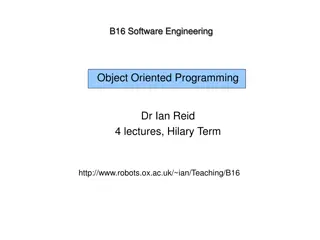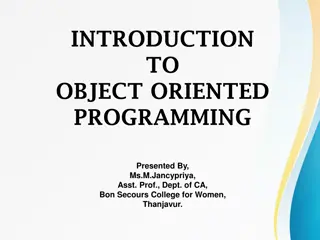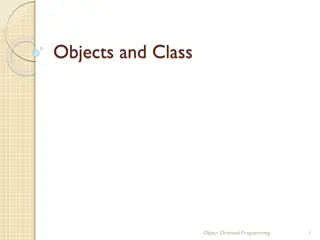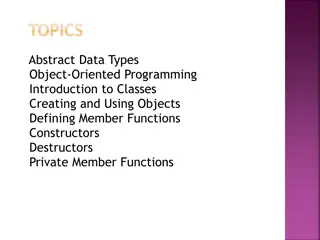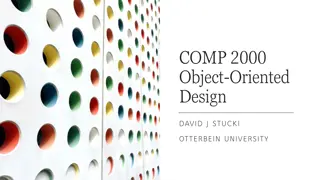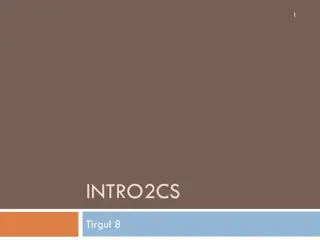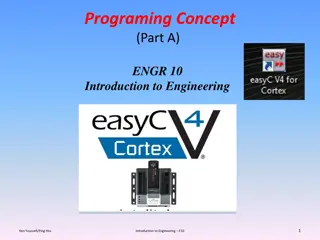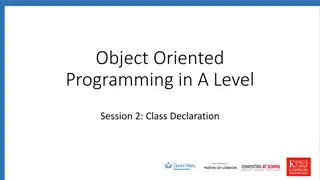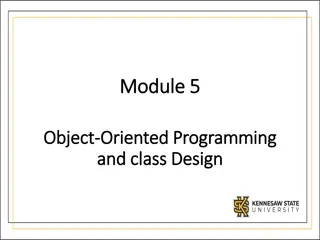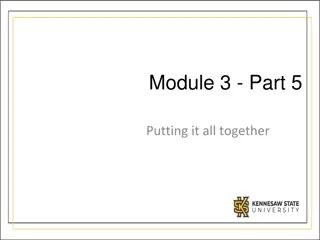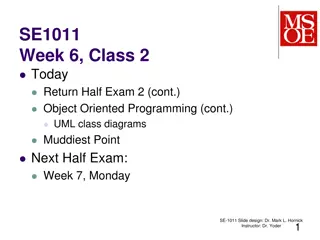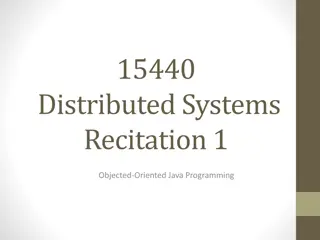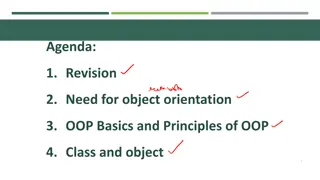Understanding Object-Oriented Programming (OOP) Concepts in Chapter 8
Delve into the world of Object-Oriented Programming (OOP) through Chapter 8 of 'Essential Computational Thinking' by Dr. Ricky J. Sethi. Explore how classes and objects form the backbone of OOP, how messages are sent between objects, and the difference between regular and object reference variables. Understand the essence of defining classes, designing user-defined data types, and the significance of well-defined characteristics and functionality in OOP.
Download Presentation

Please find below an Image/Link to download the presentation.
The content on the website is provided AS IS for your information and personal use only. It may not be sold, licensed, or shared on other websites without obtaining consent from the author. Download presentation by click this link. If you encounter any issues during the download, it is possible that the publisher has removed the file from their server.
E N D
Presentation Transcript
ESSENTIAL COMPUTATIONAL THINKING: CHAPTER 08 Dr. Ricky J. Sethi Essential Computational Thinking
Chapter 8 Object-Oriented Programming (OOP)
The story so far We ve already seen how we might create a class blueprint and use that class to create objects The class blueprint is the Class Data Type We can then use those objects to send messages, either to other objects or even to itself Sending a message, in the OOP way of thinking, means calling, or invoking, some action or service that s defined for that module or class
Classes and Objects Revisited The programs we ve written in previous examples have used pre-defined classes in the standard Java Class Library (JCL from the Java API) Now we will begin to design programs that rely on classes that we write ourselves The Class Data Type we define is thus a User-defined Data Type The class that contains the main() method is just the starting point of an application program, usually a driver program True object-oriented programming is based on defining classes that represent objects with well-defined characteristics and functionality
Regular Variables vs Object Reference Variables Normal variables are declared as: int x = 0; A variable is a symbol or name or identifier for some address in memory We can also declare object reference variables Object reference variables are names for some address in memory where the object itself lives Variables on Steroids: Variables with abilities far beyond those of mortal variables String foo = new String( Hello ); Object reference variables let you access the actual object Object itself has both attributes and behaviours!
Objects and Classes Class Data Types have: Name/TYPE Attributes/FIELDS Characteristics, State, etc. Called Instance Variables/Fields Behaviour/METHODS Services, Abilities, etc. Called Methods Those behaviours are defined by a BLUEPRINT, the CLASS DEFINITION Just like you have a blueprint for a house The blueprint can be expressed in a UML notation, as seen above Name/TYPE Attributes/FIELDS Behaviour/METHODS only main() for most of our classes/programs so far
Kinds of Applications Weve Built So Far Problem: a dog that barks: build a class to solve it! Simple Main Class: BarkingDoggies.java public class BarkingDoggies { public static void main(String[] args) { System.out.println( Woof! ); } } More General Application: BarkingDoggies.java Variables allow flexibility and reliability class BarkingDoggies { public static void main(String[] args) { String barkSound = new String( Woof! ); System.out.println( barkSound ); } }
OOP WAY: Driver and Helper Class based App Ver 1 (no Attributes) Problem: a dog that barks Driver Class Application: BarkingDoggies.java class BarkingDoggies { public static void main(String[] args) { Dog spot = new Dog(); spot.bark(); } } Helper Class: Dog.java public class Dog { public void bark() { System.out.println( Woof! ); } }
Small Driver and Helper Class based Application Ver 2 (with Attribute/Field) Problem: a dog that barks Driver Class Application: BarkingDoggies.java class BarkingDoggies { public static void main(String[] args) { Dog spot = new Dog(); spot.bark(); } } Helper Class: Dog.java public class Dog { String barkSound = new String("Woof!"); public void bark() { System.out.println(barkSound); } }
Customized Construction We can create more doggies in BarkingDoggies.java, as such: class BarkingDoggies { public static void main(String[] args) { Dog spot = new Dog(); spot.bark(); Dog fido = new Dog(); fido.bark(); } } But all the Doggies currently just say Woof! What if we want to have Spot say Woof! but Fido to say Arf! Arf! ? Define a custom Constructor Method to customize the barkSound!
Solving Problems with OOP Using Software Objects
Solving Problems with Software Objects How do we use classes and objects to actually solve computational problems? The process of creating computational solutions in an Object-Oriented paradigm involves: 1. Define the class 2. Use the class to create one or more objects 3. Have the objects send messages to each other and do stuff! Doing stuff often involves changing the data variables, or properties, of these objects The message invoked is the method, or function
A Detailed Example How exactly does this kind of message passing eventually lead to a solution? Let s examine a detailed example of setting up and using a bank account We ll write a program that allows a user to open an account and simply deposit money into that account
Start with Requirements and Specifications The requirements statement: Create new bank accounts, allow deposits of money into the accounts, and display the new balance. We can now bold the relevant nouns and underline the verbs Most nouns will likely become either objects themselves or properties (data variables) of those objects in our new program Most verbs will likely become the actions, or functions (methods) Now the specifications: Create new bank accounts, allow deposits of money into the accounts, and display the new balance.
Start with a simple main() method We start with a simple Application for Hello World Make a UML diagram for it This is a DRIVER Class Application and we keep the main() as simple as possible to get things going: class Main { public static void main(String[] args) { System.out.println( Hello World!"); } }
Add in some variable declarations Let s work on a Bank Account problem Start by creating a primitive variable Next create a variable on steroids (object reference variable) to track Bank Accounts for multiple people like John/Pat/Mindy class Main { public static void main(String[] args) { int x = 0; // Doesn t do anything! // Create an object reference VARIABLE *only* Account johnsAccount; } }
We need an Account Class or TYPE Compiler doesn t know Account data type by default Need a user-defined data type: Class Data Type! Let s outline the Account Class UML class Main { public static void main(String[] args) { int x; x = 5; // Create an object reference VARIABLE Account johnsAccount; // Create the new OBJECT in memory now johnsAccount = new Account(); } } class Account { }
Lets add in a Service/Method/Behaviour Our Account object reference VARIABLE hasn t taken enough steroids doesn t do anything yet! Let s add in the ability to return the current balance Use the DOT OPERATOR class Main { public static void main(String[] args) { // Create an object reference VARIABLE and INITIALIZE object Account johnsAccount = new Account(); System.out.println("Balance for John: "+ johnsAccount.getBalance()); } } class Account { // -------------------------------------------- // Returns balance amount // -------------------------------------------- public double getBalance() { return 50; } }
We can use the Class Data Type to create Multiple Objects Let s create multiple bank account objects now! OOPS! They both have the same balance! class Main { public static void main(String[] args) { // Create an object reference VARIABLE and INITIALIZE object Account johnsAccount = new Account(); System.out.println("Balance for John: "+ johnsAccount.getBalance()); // Create ANOTHER object reference VARIABLE and INITIALIZE object Account patsAccount = new Account(); System.out.println("Balance for Pat: "+ patsAccount.getBalance()); } } class Account { // -------------------------------------------- // Returns balance amount // -------------------------------------------- public double getBalance() { return 50; } }
Extend the Class Data Type Functionality First, we define the Class Data Type: // DEFINE CLASS Account: class Account { // Hidden Data Structure private double balance; // PUBLIC Method public void getBalance() { System.out.println("Balance is: $"+ balance); } // PUBLIC Method public void makeDeposit(double depositAmount) { System.out.println(" --> Depositing $"+ depositAmount); balance = balance + depositAmount; } }
Now the main program/driver class The main driver application: // MAIN Program Here: public class Main { public static void main(String[] args) { // Create a new Account object called joeAccount Account joeAccount = new Account(); // Check balance in Joe's Account & make some deposits joeAccount.printBalance(); joeAccount.makeDeposit(30); joeAccount.printBalance(); joeAccount.makeDeposit(100); joeAccount.printBalance(); } }
Add a Constructor to initialize objects A Constructor is like the Contractor a Builder might hire The Class Data Type DEFINITION is like a BLUEPRINT Object-specific DATA is stored in FIELDS/INSTANCE VARIABLES This DATA determines the STATE of the OBJECT The Constructor initializes these FIELDS/INSTANCE VARIABLES Declared INSIDE a Class Definition but OUTSIDE any Method Definition class Main { public static void main(String[] args) { Account johnsAccount = new Account(50); System.out.println("Balance for John: "+ johnsAccount.getBalance()); Account patsAccount = new Account(50000); System.out.println("Balance for Pat: "+ patsAccount.getBalance()); } } class Account { private double balance; Difference between LOCAL variables and INSTANCE variables public Account(double initialBalance) { balance = initialBalance; } public double getBalance() { return balance; } }
Primitive vs Object Variables Java consists of both primitive variables, like x, as well as object variables, like joeAccount Object variables are like variables on steroids : They can both hold values and you can also pass messages to them Instead of a single item (the value) used to instantiate a primitive variable, instantiating an object variable requires three items: The new operator to start the process of building a new object The name of the class blueprint used to build the object Optional value(s) to initialize the object 1. 2. 3.
Object Reference Variables Object Reference Variable vs Primitive Variable
Identifying Classes and Objects The main task of object-oriented design is determining the classes and objects that will constitute the computational solution The classes may be part of a class library, reused from a previous project, or newly written One way to identify potential classes is to identify the objects mentioned in the requirements document The objects usually correspond to the nouns in the requirements document and the methods or services that an object provides generally correspond to the verbs
Identifying Classes and Objects Excerpt from a requirements (not specifications) document: The user must be allowed to specify each product by its primary characteristics, including its name and product number. If the bar code does not match the product, then an error should be generated to the message window and entered into the error log. The summary report of all transactions must be structured as specified in section 7.A. Nota Bene: all nouns/verbs will not correspond to a class/object/method in the final computational solution But most Nouns will usually correspond to objects/classes or attributes and most Verbs will usually correspond to methods
Identifying Classes and Objects Remember that a class represents a group (or category or classification) of objects with the same behaviors Generally, classes that represent objects and should be given names that are singular nouns For example, names like: Coin, Student, Message A class represents the concept of one such object We are free to instantiate as many objects of each class as we need in the computational solution
Identifying Classes and Responsibilities Part of identifying the classes we need in a computational solution involves assigning responsibilities to each class Every activity that a program will do has to be represented by one or more methods within a class In the early stages of software development, we don t have to decide every method of every class Instead, we begin with the primary responsibilities and then evolve the design in an iterative fashion


